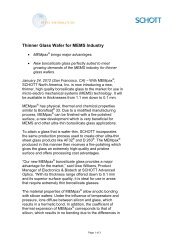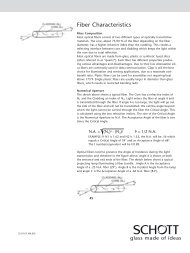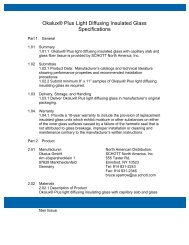Optical Filters 2013 - SCHOTT North America
Optical Filters 2013 - SCHOTT North America
Optical Filters 2013 - SCHOTT North America
Create successful ePaper yourself
Turn your PDF publications into a flip-book with our unique Google optimized e-Paper software.
72. Basic information on interference filtersInterference filters leverage (as the name implies) the physical effect of the interferenceof light waves. This is illustrated in Fig. 2.1 for the case of constructiveand destructive interference.Constructive interferenceDestructive interferenceE 1E 1λ/2Light wave 1Light wave 1position zposition zE 2E 2Fig. 2.1Interference of two light waves for constructiveinterference (left): the two light waves are inphase and add to a superposition of both waves.In contrast, for destructive interference (right)one light wave is half a wavelength out of phaseleading to light cancelation of the superposition.Light wave 2E = E 1 + E 2Sum ofwave 1 + wave 2position zposition zLight wave 2λ/2 out of phaseE = E 1 + E 2Sum ofwave 1 + wave 2position zposition zAs we can see from Fig. 2.1, if the two light waves are half a wavelength (or anodd number of half a wavelength) out of phase, then the superposition of bothlight waves leads to a cancellation of the resulting light if both waves have thesame amplitude. It is precisely this light cancellation that is exploited for antireflective(AR) coatings, where no light is reflected (back), therefore all light istransmitted. Half a wavelength (λ/2) phase difference can be achieved by usinga thin-film layer that is λ/4 thick, see Fig. 2.2.Fig. 2.2A light wave entering a thin-film layer of thicknessλ/4 is reflected backwards at the interfacethin-film layer-substrate and thus travels thethickness λ/4 twice resulting in a phase differenceof λ/2 (half a wavelength).λ/4Incoming light waveThin-film layerSubstrateWave goes thickness λ/4down and up = 2 · λ/4 = λ/2;phase difference = λ/2As shown in Fig. 2.2, a thin-film layer coating of thickness λ/4 generates a phasedifference of half a wavelength (λ/2) for the wave traveling backwards. Therefore,no light is reflected back, thus all light must be transmitted. This is illustrated inFig. 2.3.
















